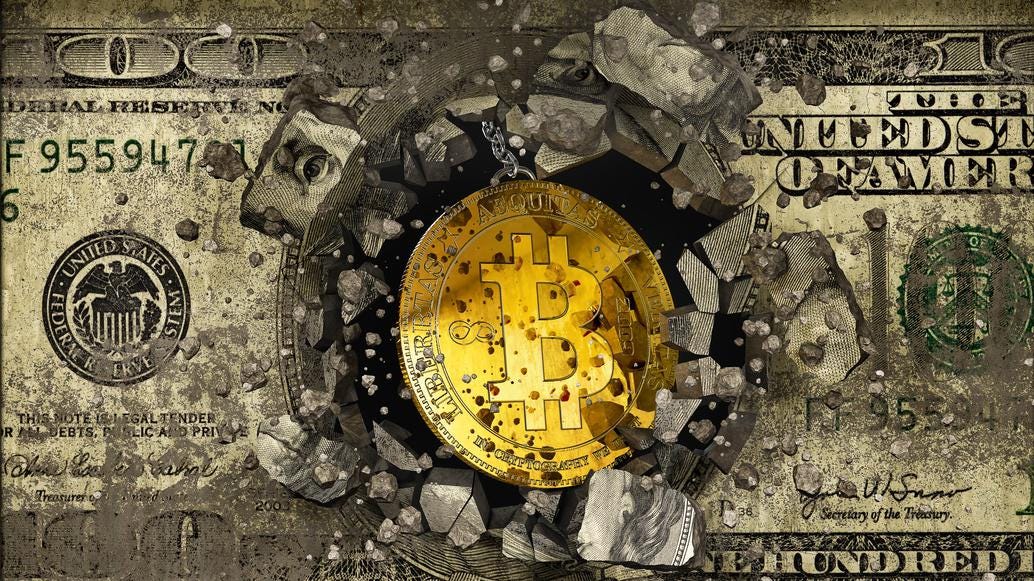Concept of bitcoin destroying the concrete wall with dollar graffiti, 3d illustration
On November 8, 2021. Time Magazine said, “The cryptocurrency market is now worth more than $3 trillion.” (It hit $3.2 trillion.)
Today – December 16, 2022 – a year and a month later, it’s worth $864 billion – a 73% loss. It’s probably not done.
Further, said Time, “The little more than a decade old market for digital assets has already roughly quadrupled from its 2020 year-end value, as investors have gotten more comfortable with established tokens…” Let’s stop right there. Still comfortable?
Time’s report went on: “Excitement about the possibilities of decentralized finance and non-fungible tokens is growing.” Let’s stop right there – again. In the 5,000-year history of currency. decentralization was never what made it work. The success of currency – and of currencies – was the trust that two or more parties in a transaction had in the enduring value of currency – and in who was handling it. It wasn’t people like Sam Bankman-Fried or organizations like FTX.
Around 3,000 BC in Mesopotamia, when currency was established as a representative of equivalent value, great care was given to its stewardship. Standards were set and met, Regulation and accountability were respected. Repositories of currencies – in the form of grains, perhaps – eventually became the forerunners of what we call central banks, enabling the trade routes. In all, the success of currencies through the years – Aristotle had plenty to say about this, as did the Romans – was based on trust, regulation, and centrality.
Sadly, the financial devastation young Sam caused was not the first time a financial or currency system was misused or abused. If young Sam, 30, knew a little more about the history of currency or – more recently – of financial crashes – it’s a decent bet that he, the child of two scholarly professors at Stanford, would probably have acted differently. At least, one would like to think. It appears he either didn’t know the history of what he was involved in – or didn’t care.
Here are just four of the biggest market disasters that have elements of what he created. But either he knew less than he should have or, worse, knew what he was doing but did it anyway.
Wall Street Crash of 1929 (“Black Tuesday”)
Stock prices dropped on October 24, briefly rallied, and then tanked on October 28-29. The Dow dropped 25% in what became known as Black Tuesday. Subsequently, the market lost 85% of its value.
Why it happened
Through the Roaring Twenties, a rising spiral of speculation, coupled with overproduction in
factories made investors overly giddy. They took on excessive unchecked debt, apparently believing there was no end to the heights the market could reach. Until, that is, they realized the market overheated and – in droves – the smart ones cashed out.
“Black Monday,” 1987
On October 19 – 58 years, almost to the day, after the 1929 debacle – the Dow dropped 23%, while the S&P lost more than 20% and Nasdaq lost 11%. Around the world, stock exchanges also tumbled. (Of no historical importance but of interest, in Australia and New Zealand, this was called “Black Tuesday,” as they are on the other side of the international date line.)
Why it happened
More than sinking oil prices and escalating tensions in the Middle East, the relatively new – and largely unchecked prevalence of trading conducted by supercomputers paved the way for well-positioned brokers to place huge orders and to do them so fast that they were completed before most other investors knew they were begun.. Unfortunately, they also made it difficult to stop trades soon enough once prices started going over the cliff. This was more chaotic than an elementary school playground during recess. The result was the largest single-day loss in the Dow’s history.
The Dot-Com Bubble Burst of 2000 and Beyond
During the internet-revolutionized 1990s, you couldn’t help but see – and be tempted to invest in – just about any company with a “.com” at the end of its name. Their stocks went sky-high, with 12 of them – large cap – rising more than 1,000%. That was fun – while it lasted. To too many investors, the thought that this kind of growth having a limit was just unthinkable – until it became a reality. The sell-off started, picked up steam, became a rampage, and by October 2002 (there’s that fateful month again), Nasdaq had fallen more than 75% from its March 2000 peak of just over 5,000.
Why it happened
Aside from money policies being loose, passion ruled the day, sending the equivalent of 500 volts through a 100-volt circuit.
The Sub-Prime Mortgage Crisis of 2007-08
The real estate market was white-hot and lenders, smelling blood in the water in the shape of obscene commissions, started practically giving mortgage money away, mostly to unqualified borrowers. Investors bought up mortgage-backed securities and other subprime loans. It got out of hand in a hurry and mass defaults led to property prices falling followed by investments turning sour. The stock market lost 20%. Unemployment neared 10%. Before it was over, Bear Stearns and Lehman Brothers were gone. Other giants survived, but hardly. The result was the Great Recession of 2008-09.
Why it happened
Greed, lack of strong regulations or flat-out disregard for them, repudiation of good business practices, and underlying it all, an appalling lack of understanding of historic precedent, as outlined above. You know what they say about history, right?
And that brings us to…
FTX and Sam Bankman-Fried, 2022
Isn’t this, quite frankly, just another “SSDD” situation? The story of young Sam is nothing more than a reiteration of the above vignettes: greed, unfettered activity, deceit, subterfuge, hyperbole, fraud, disregard, recklessness, belligerence, self-centeredness, and a “because I can” attitude.
Now…still comfortable?
Author
Administraroot


